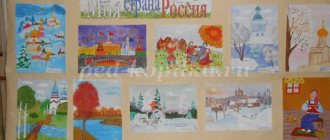Exciting experiments with magnets for children with explanations
We suggest considering experiments with magnets using ingenuity and ingenuity. For example, heat has a destructive effect on magnetic properties.
With a candle
We also propose to refute the theory that only iron is subject to magnetic influence. An exception is, for example, matches.
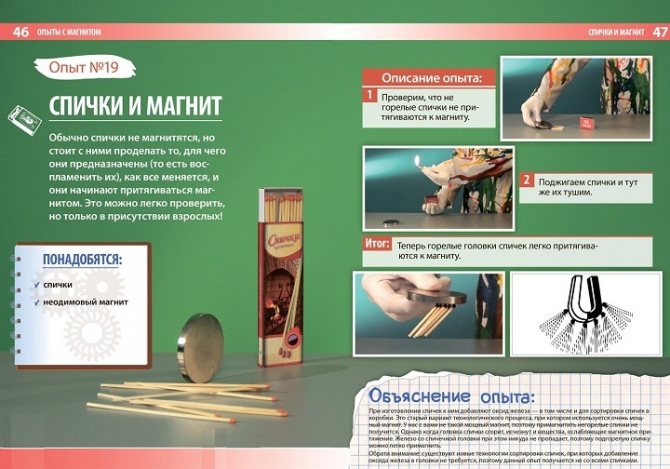
With matches
Let's improve the theory about the strength of a magnet a little.
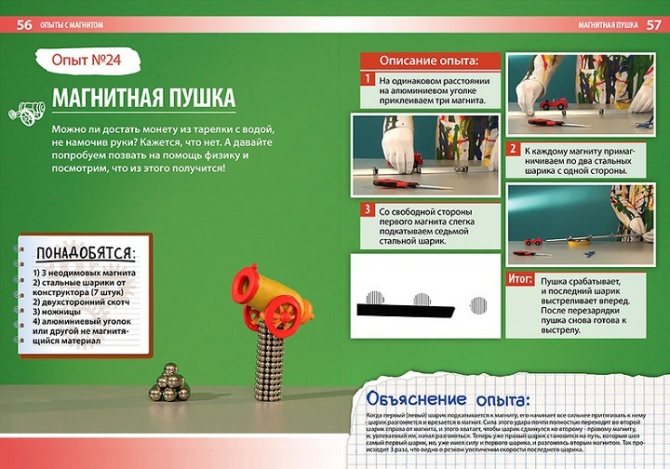
Magnetic gun
We suggest creating a magnetic mechanism with your own hands.
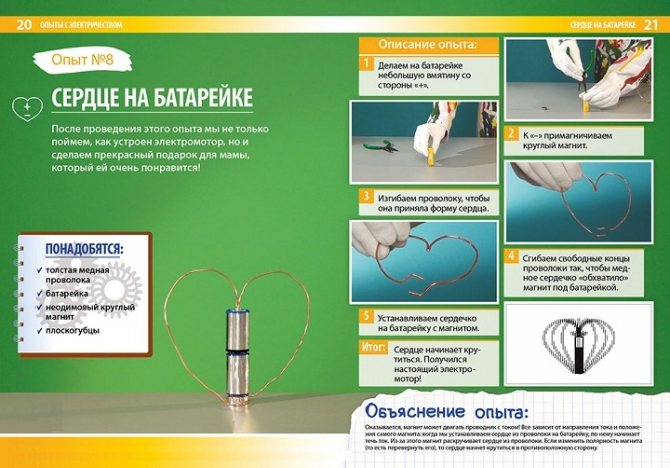
Experiment
Using a similar algorithm, you can try different shapes of wire.
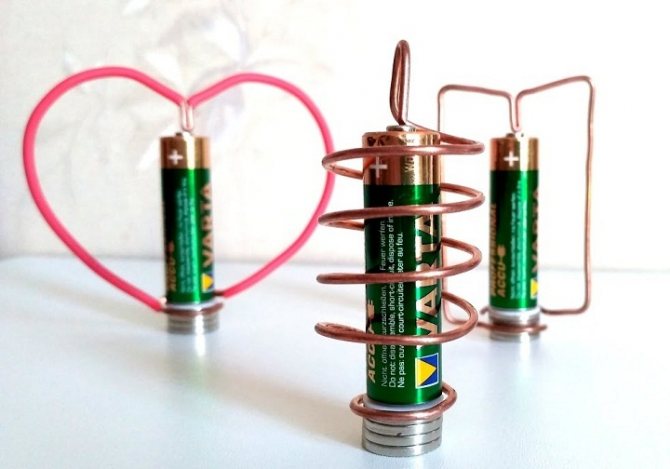
Rotation under magnetic influence
Or you can make a homemade fan! By the way, if you change the pole that touches the magnet, the direction of movement of the wire will change.
Experiment
Or you can make such an engine with your own hands.
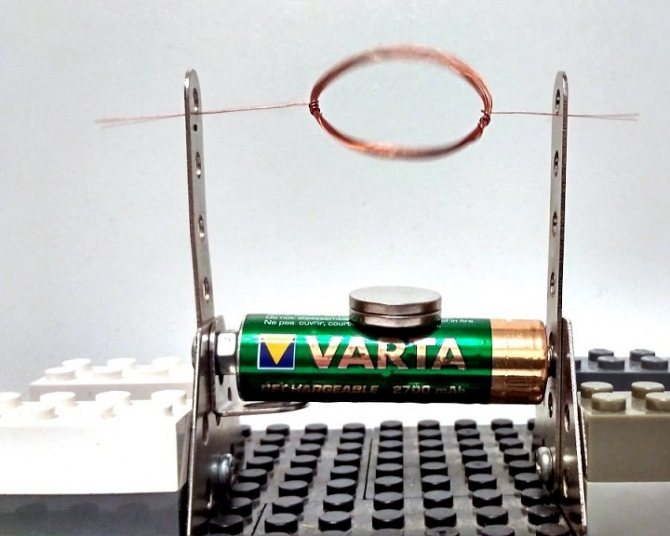
Engine
And finally, create an almost perpetual motion machine from a magnet, a battery and copper wire (if you close the wire in a circle). Until the battery runs out. All these experiments operate on the principle of a simple electric motor - electrons move along a wire, and a force acts on them.
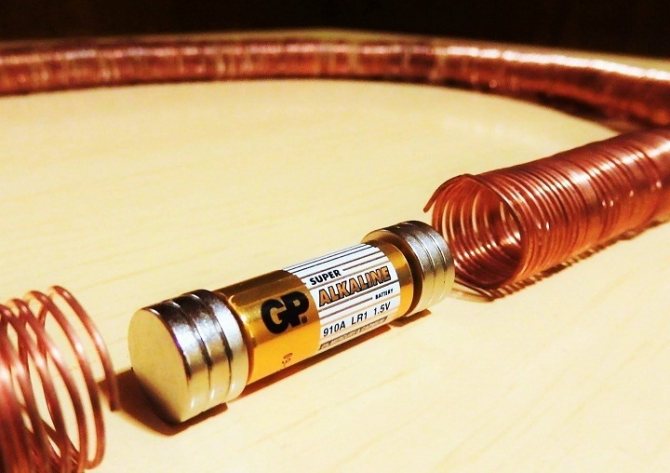
Magnetic train
Don't be afraid to experiment - experiments with magnets are so exciting and varied that they can surprise even adults.
miracle of magnetic experiments and experiments (preparatory group) on the topic
Is everything attracted by magnets?
Purpose: Determine the properties of magnets to attract metal objects
Materials: objects made of wood, metals, plastics, steel, paper; magnet.
During the experiment, it is necessary to divide all objects into two groups: metal and non-metal. Bring the magnet one by one to the objects of the first and second groups. We define that non-metallic objects are not attracted to a magnet, but some metallic objects are attracted to a magnet, and some are not attracted to it.
Conclusion: magnets have the ability to attract objects made of iron or steel, nickel and some other metals. Wood, plastic, paper, fabric do not react to magnets.
“How to get a paperclip out of water without getting your hands wet”
Goal: Continue to introduce children to the properties of magnets in water.
Material: A glass of water, iron objects, magnet.
While putting away paper clips after the children's experiments, Uznayka "accidentally" drops some of them into a glass of water. The question arises, how to get paper clips out of the water without getting your hands wet. After the children manage to pull the paper clips out of the water using a magnet, it turns out that the magnet acts on iron objects in the water. Same experience with sand.
Conclusion. Water does not interfere with the action of the magnet. Magnets act on iron and steel even if they are separated from it by water.
"The Power of Magnets"
Purpose: To introduce a method for comparing the strength of a magnet.
Material: Large horseshoe-shaped and medium-sized strip magnet, paper clips.
Invite the children to determine which magnet is stronger - a large horseshoe or a medium-sized strip magnet (this could be a dispute in which fairy-tale characters well known to children participate). Consider each of the children's suggestions on how to find out which magnet is stronger. Children do not have to formulate their proposals verbally. A child can express his thought visually by acting with the objects necessary for this, and the teacher (or the gnome Uznayka) together with others helps to verbalize it.
As a result of the discussion, two ways to compare the strength of magnets emerge:
1. by distance - the magnet that will attract the steel object (paper clip) is stronger at a greater distance (the distances between the magnet and the place where the paper clip attracted by it is located are compared);
2. by the number of paper clips - the stronger magnet is the one that holds a chain with a large number of steel paper clips at its pole (the number of paper clips in the chains “grown” at the poles of the magnets is compared), or by the density of the iron filings stuck to the magnet.
Pay attention to the experiments - “tips” with two magnets of different strengths, which can be shown to children if they have difficulties:
1. identical steel paper clips attract one of the magnets from a greater distance than the other;
2. one magnet holds a whole chain with more paper clips at its pole than the other (or a thicker “beard” of iron filings).
In these experiments, have children determine which magnet is stronger and then explain how they figured out what “tipped” them to the answer.
After counting the number of paper clips at the poles of different magnets and comparing them, children come to the conclusion that the strength of a magnet can be measured by the number of paper clips held in a chain near its pole.
Thus, the paperclip in this case is a “yardstick” for measuring the strength of the magnet.
Additionally. Instead of paper clips, you can take other steel objects (for example, screws, pieces of steel wire, etc.) and make chains from them at the magnet poles. This will help children become convinced of the conventionality of the chosen “measure” and the possibility of replacing it with others.
Conclusion: The shape and size of a magnet affects its strength. Horseshoe magnets are stronger than rectangular magnets. Among magnets that have the same shape, a larger magnet will be stronger. Magnets attract even from a distance. The larger the magnet, the greater the force of attraction and the greater the distance over which the magnet exerts its influence.
Magnets have the property of attracting metal objects. Magnetic force can act through various objects and over a considerable distance. Not all magnets are the same, different magnets have different strengths, this strength depends on the shape and size of the magnet.
“What determines the strength of a magnet?”
Goal: To develop logical and mathematical experience in the process of comparing the strength of a magnet through objects.
Material: Large tin can, small piece of steel.
The confused gnome suggests making a large magnet. He is confident that a large iron can will produce a strong magnet - stronger than a small piece of steel.
Children give their suggestions as to what would make the best magnet: a large tin can or a small piece of steel.
You can test these proposals experimentally: try to rub both objects equally, and then determine which of them is stronger (the strength of the resulting magnets can be judged by the length of the “chain” of identical iron objects held at the magnetic pole).
But for such an experimental test, a number of problems must be solved. In order to rub both future magnets equally, you can:
- rub both pieces of steel using the same number of movements (two children rub, and two teams count the number of movements made by each of them);
- rub them for the same amount of time and do it at the same pace (in this case, to record the time of rubbing, you can use an hourglass or a stopwatch, or simply start and finish this action for two children at the same time - with a clap; to maintain the same pace in this case, you can use a uniform check).
Conclusion: that a stronger magnet is obtained from steel objects (for example, from a steel needle). A tin can produces a very weak magnet or no magnet at all. The size of the item doesn't matter.
“Electricity helps make a magnet”
Purpose: To introduce children to the method of making a magnet using electric current.
Material: A battery from a flashlight and a spool of thread, onto which insulated copper wire 0.3 mm thick is evenly wound.
The future magnet (steel rod, needles, etc.) is inserted inside the coil (as a core). The size of the future magnet should be such that its ends protrude somewhat from the coil. By connecting the ends of the wire wound on a coil to a flashlight battery and thereby running an electric current through the wire of the coil, we will magnetize the steel objects located inside the coil (the needles should be inserted inside the coil, with their “ears” in one direction and their points in one direction). another).
In this case, the magnet, as a rule, is stronger than when it is made by rubbing a steel strip.
“Which magnet is stronger?”
Purpose: Compare the strengths of magnets made in different ways.
Material: Three magnets of different shapes and sizes, steel clips and other metals.
Invite children to compare the properties of three magnets (using paperclips or other steel objects as “yardsticks” to measure the strength of the magnets):
- the magnet resulting from this experiment;
- a magnet made by rubbing a steel strip;
- factory-made magnet.
"Magnetic needle"
Purpose: To introduce the properties of a magnetic needle.
Material: Magnet, magnetic needle on a stand, needle, red and blue stripes, cork, vessel with water.
Show the children a magnetic needle (on a stand), give them the opportunity to experimentally verify that it is a magnet.
Have children place the magnetic arrow on the stand (making sure it can rotate freely on it). After the arrow stops, children compare the location of its poles with the location of the poles of magnets rotating on threads (or with magnets floating in bowls of water), and come to the conclusion that their locations coincide. This means that the magnetic needle - like all magnets - shows where the Earth is north and where it is south.
Note. If your location does not have a magnetic needle on the stand, you can replace it with an ordinary needle. To do this, you need to magnetize it, marking the north and south poles, respectively, with stripes of red and blue paper (or thread). Then place the needle on the cork, and place the cork in a flat vessel with water. Floating freely in the water, the needle will turn in the same direction as the magnets.
"Compass"
Purpose: To introduce the device, the operation of the compass and its functions.
Material: Compass.
1. Each child places the compass on the palm of his hand and, having “opened” it (an adult shows how to do this), watches the movement of the arrow. As a result, the children once again figure out where is north and where is south (this time using a compass).
Game "Teams".
Children stand up, put compasses on their palms, open them and follow the commands. For example: take two steps north, then two steps south, three more steps north, one step south, etc.
Teach children to find west and east using a compass.
To do this, find out what the letters – S, Yu, Z, V – mean, which are written inside the compass.
Then have the children turn the compass on their palm so that the blue end of its arrow “looks” at the letter C, i.e. - on North. Then the arrow (or match), which (mentally) connects the letters Z and B, will show the direction “west - east” (actions with a cardboard arrow or match). Thus, children find west and east. A game of “Teams” with “use” of all sides of the horizon.
“When a magnet is harmful”
Purpose: To introduce how a magnet acts on its surroundings.
Material: Compass, magnet.
- Let the children express their guesses about what will happen if you bring a magnet to the compass? - What will happen to the arrow? Will she change her position?
- Test children's assumptions experimentally. By holding the magnet close to the compass, children will see that the compass needle moves with the magnet.
- Explain the observation: a magnet that approaches a magnetic needle affects it more strongly than earthly magnetism; the arrow-magnet is attracted to a magnet that has a stronger effect on it compared to the Earth.
- Remove the magnet and compare the readings of the compass with which all these experiments were carried out with the readings of others: it began to show the sides of the horizon incorrectly.
Find out with your children that such “tricks” with a magnet are harmful to the compass - its readings “get lost” (therefore, it is better to take only one compass for this experiment).
- Tell the children (you can do this on behalf of Find out) that a magnet is also harmful for many devices, the iron or steel of which can become magnetized and begin to attract various iron objects. Because of this, the readings of such devices become incorrect.
A magnet is harmful to audio and video cassettes: both the sound and the image on them can deteriorate and become distorted.
It turns out that a very strong magnet is also harmful for humans, since both humans and animals have iron in their blood, which is affected by the magnet, although this is not felt.
Find out with your children whether a magnet is harmful to the TV. If you bring a strong magnet to the screen of a switched-on TV, the image will be distorted and the color may disappear. after the magnet is removed, both should be restored.
Please note that such experiments are dangerous for the “health” of the TV also because a magnet can accidentally scratch the screen or even break it.
Let the children remember and tell Learn about how to “protect themselves” from a magnet (using a steel screen, a magnetic anchor.
"Earth is a magnet"
Purpose: To identify the actions of the Earth's magnetic forces.
Material: A plasticine ball with a magnetized safety pin attached to it, a magnet, a glass of water, regular needles, vegetable oil.
Conducting the experiment. An adult asks the children what will happen to the pin if you bring a magnet to it (it will be attracted because it is metal). They check the effect of a magnet on a pin, bringing it to different poles, and explain what they saw.
Children find out how a needle will behave near a magnet by performing an experiment according to the algorithm: lubricate the needle with vegetable oil and carefully lower it to the surface of the water. From afar, slowly, at the level of the water surface, a magnet is brought up: the needle turns its end towards the magnet.
Children lubricate the magnetized needle with fat and carefully lower it to the surface of the water. Notice the direction and carefully rotate the glass (the needle returns to its original position). Children explain what is happening by the action of the Earth's magnetic forces. Then they examine the compass and its structure, compare the direction of the compass arrow and the needle in the glass.
"Polar Lights"
Goal: Understand that the aurora is a manifestation of the Earth’s magnetic forces.
Materials: Magnet, metal filings, two sheets of paper, cocktail straw, balloon, small pieces of paper.
Conducting the experiment. Children place a magnet under a sheet of paper. From another sheet at a distance of 15 cm, metal filings are blown through a tube onto the paper. Find out what is happening (the sawdust is arranged in accordance with the poles of the magnet). The adult explains that the magnetic forces of the earth act in the same way, delaying the solar wind, the particles of which, moving towards the poles, collide with air particles and glow. Children, together with an adult, observe the attraction of small pieces of paper to a balloon electrified by friction with hair (the pieces of paper are particles of the solar wind, the balloon is the Earth).
"An unusual picture"
Goal: Explain the action of magnetic forces, use knowledge to create a picture.
Material: Magnets of various shapes, metal filings, paraffin, a strainer, a candle, two glass plates.
Conducting the experiment. Children look at a painting made using magnets and metal filings on a paraffin plate. The adult invites the children to find out how it was created. Check the effect of magnets of different shapes on sawdust by pouring them onto paper under which the magnet is placed. They consider the algorithm for making an unusual picture, perform all the steps sequentially: cover a glass plate with paraffin, install it on magnets, pour sawdust through a sieve; lifting it, heat the plate over the candle, cover it with a second plate, and make a frame.
"Magnet draws the Milky Way"
Goal: to introduce children to the property of a magnet to attract metal, to develop interest in experimental activities.
Material: magnet, metal filings, sheet of paper with a picture of the night sky.
Conducting the experiment. Observe with adults the night sky, in which the Milky Way is clearly visible. Pour sawdust into a wide strip onto the sky map, simulating the Milky Way. We bring the magnet on the back side and slowly move it. Sawdust representing constellations begin to move across the starry sky. Where the magnet has a positive pole, the sawdust is attracted to each other, creating unusual planets. Where the magnet has a negative pole, the sawdust repels each other, representing separate night luminaries.
"Magnetic Theater"
Goal: To develop the creative imagination of children in the process of finding ways to use magnets, dramatizing fairy tales for the “magnetic” theater. Expand the social experience of children in the process of joint activities (distribution of responsibilities). To develop emotional and sensory experience and speech of children in the process of dramatization games.
Material: Magnet, steel clips, sheets of paper. Materials needed for drawing, appliqué, origami (paper, brushes and paints or pencils, felt-tip pens, scissors, glue).
As a surprise for the gnome Wizard's birthday, children are invited to prepare a performance in the theater that uses magnets (the gnome Wizard is very passionate about them).
A “hint” for setting up a magnetic theater is an experiment in which a paper clip moves along a paper screen under the influence of a magnet.
As a result of searches - experimentation, reflection, discussion - children come to the conclusion that if any light steel objects (paper clips, circles, etc.) are attached to paper figures, then they will be held by a magnet and move across the screen with help (the magnet is brought to the screen from the other side, invisible to the viewer).
After choosing a fairy tale to stage in a magnetic theater, children draw scenery on a paper stage-screen and make “actors” - paper figures with pieces of steel attached to them (they move under the influence of magnets controlled by children). At the same time, each child chooses the most acceptable ways for him to portray the “actors”:
- Draw and cut out;
- Making an application;
- Made using origami method, etc.
In addition, it is advisable to make special invitations for the gnome Wizard and all other guests. For example, these: We invite everyone to the first performance of the amateur children's magnetic theater “MIRACLE-MAGNET”.
"Catch a Fish"
Goal: To develop children's creative imagination in the process of finding ways to use magnets and inventing stories for games using them. Expand the transformative and creative experience of children in the process of constructing games (drawing, coloring, cutting them out). Expand the social experience of children in the process of joint activities - the distribution of responsibilities between its participants, the establishment of work deadlines, and the obligation to comply with them.
Material: Board game “catch the fish”; books and illustrations that help children come up with plots for “magnetic” games; materials and tools necessary for making the game “Catch the Fish” and other “magnetic” games (in quantities sufficient for every child to take part in the making of such games).
Invite the children to look at the printed board game “Catch a Fish”, tell how to play it, what the rules are and explain why the fish are “caught”: what they are made of, what the “fishing rod” is made of, how and thanks to which they manage to “catch” paper fish with a fishing rod and magnet.
Invite the children to make such a game themselves. Discuss what is needed to make it - what materials and tools, how to organize the work (in what order to do it, how to distribute responsibilities between the “manufacturers”).
As the children work, draw their attention to the fact that all of them - the “makers” - depend on each other: until each of them finishes their part of the work, the game cannot be made.
After the game is ready, invite the children to play it.



